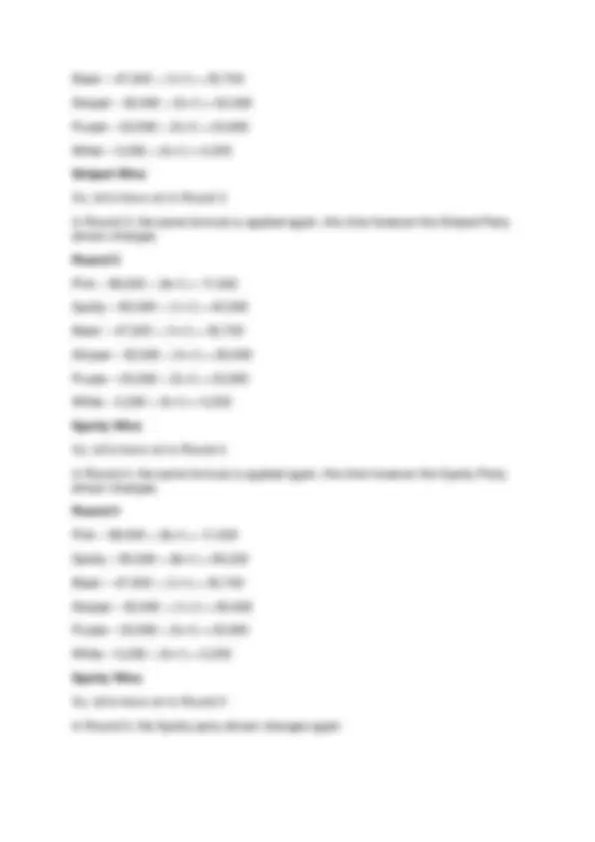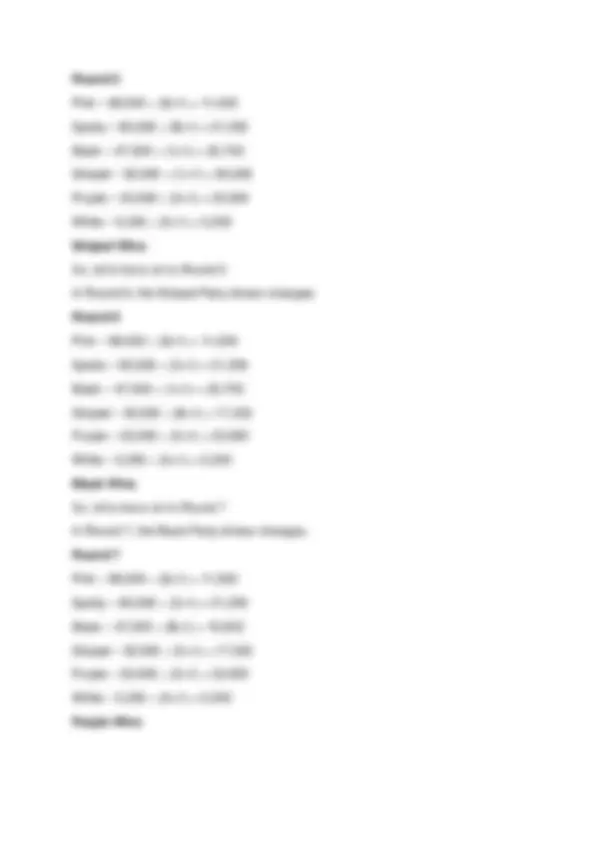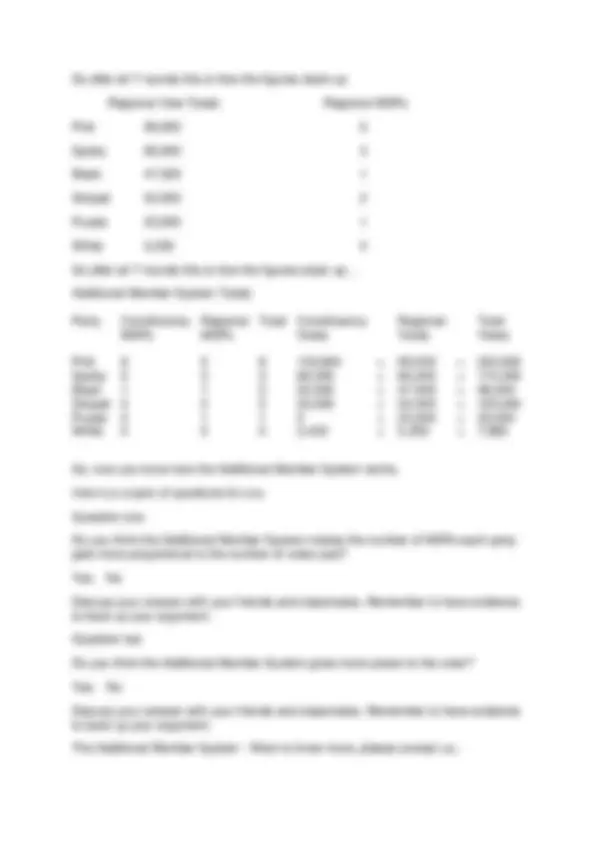





Study with the several resources on Docsity

Earn points by helping other students or get them with a premium plan


Prepare for your exams
Study with the several resources on Docsity

Earn points to download
Earn points by helping other students or get them with a premium plan
Community
Ask the community for help and clear up your study doubts
Discover the best universities in your country according to Docsity users
Free resources
Download our free guides on studying techniques, anxiety management strategies, and thesis advice from Docsity tutors
The Additional Member System is a proportional representation method used in elections to make the results more reflective of the votes cast. how the system works through an example in Scotland, using the D'Hondt Formula to elect regional MSPs. Students will learn about the role of constituency and regional votes, the concept of divisors, and the distribution of seats among parties.
What you will learn
Typology: Study notes
1 / 6

This page cannot be seen from the preview
Don't miss anything!




Elections and voting
The Additional Member System
Hi! Let me explain what it is...
The Additional Member System is a form of proportional representation which aims to make the results of an election reflect more closely the amount of votes cast for each party or individual.
The Additional Member System combines First Past the Post in constituencies and a regional system which elects 56 additional members to the Parliament.
Let me explain
At a Scottish Parliament election, each voter has two votes
One is your Constituency Vote the other is your Regional vote.
This vote (illustration of a constituency ballot paper) is used to elect the local constituency MSP.
The constituency vote is counted and the person with the most votes wins. This is known as First Past the Post.
You use your second vote (illustration of a regional ballot paper) to choose a political party, or a candidate standing as an individual, within a larger electoral area known as a region.
The region is made up of several constituencies.
The regional votes are counted.
Regional seats are decided using the D’Hondt Formula
The D’Hondt Formula - how does it work?
Regional seats are decided using the D’Hondt Formula (Victor D’Hondt was a Belgian mathematician)
Regional Votes ÷ Number of MSPs already won in region + 1
The Party or person with the largest number after this formula is applied wins the round and wins one regional MSP.
This formula will be used 7 times in 7 rounds to elect 7 regional MSPs.
With me so far...let’s go to round 1
Let’s take an example of a region
Our region is called “Anywhere”. It is made up of 9 constituencies.
Voters could choose between six political parties; the Pink Party, the Spotty Party, the Black Party, the Striped Party, the Purple Party and the White Party
The Pink Party won 8 of these constituencies and the Black Party won the other.
Let's look at the numbers we're using and where they come from...
Round 1
Pink – 99,000 ÷ (8+1) = 11,
Spotty – 85,000 ÷ (0+1) = 85,
Black – 47,500 ÷ (1+1) = 23,
Striped – 52,000 ÷ (0+1) = 52,
Purple – 23,000 ÷ (0+1) = 23,
White – 5,250 ÷ (0+1) = 5,
In the regional vote, the Pink Party got 99,000 votes. It gained 8 constituency MSPs in the area that makes the region. One is added to 8 to make the divisor for the Pink Party. The D'Hondt formula for the Pink Party for round 1 is 99,000 ÷ (8+1). Their result for round 1 is 11,000.
The Spotty Party got 85,000 votes in the regional ballot. They didn't win any of the 9 constituencies in the region so the D'Hondt formula for them is 85,000 ÷ (0+1). Their result for round 1 is 85,
The Black Party has 47,500 votes from the regional ballot and they won 1 constituency in the region. The formula for the Black Party is 47,500 ÷ (1+1). Their result for round 1 is 23,
The Striped, Purple and White Parties got 52,000, 23,000 and 5,250 votes. None of these parties won a constituency in the region, so their regional votes are divided by 0+1, giving them 52,000, 23,000 and 5,250.
So the result from round 1 is...
The Spotty Party has the largest number after the D’Hondt formula has been applied, so this Party gets 1 of the regional MSPs.
This formula would be used 7 times in 7 rounds to elect 7 regional MSPs.
Let’s recap: the D’Hondt formula is the number of regional votes divided by the number of MSPs the party has in the region + 1.
In Round 2, the Spotty Party’s divisor will change as they won an MSP in Round 1.
So, let's move on to Round 2
In round 2, the same formula is applied, but the Spotty Party divisor changes
Round 2
Pink – 99,000 ÷ (8+1) = 11,
Spotty – 85,000 ÷ ( 1 +1) = 42,
So after all 7 rounds this is how the figures stack up
Regional Vote Totals Regional MSPs
Pink 99,000 0
Spotty 85,000 3
Black 47,500 1
Striped 52,000 2
Purple 23,000 1
White 5,250 0
So after all 7 rounds this is how the figures stack up...
Additional Member System Totals
Party Constituency MSPs
Regional MSPs
Total Constituency Votes
Regional Votes
Total Votes
Pink 8 0 8 133,600 + 99,000 = 232, Spotty 0 3 3 89,300 + 85,000 = 174, Black 1 1 2 52,000 + 47,500 = 99, Striped 0 2 2 53,000 + 52,000 = 105, Purple 0 1 1 0 + 23,000 = 23, White 0 0 0 2,430 + 5,250 = 7,
So, now you know how the Additional Member System works.
Here’s a couple of questions for you
Question one
Do you think the Additional Member System makes the number of MSPs each party gets more proportional to the number of votes cast?
Yes No
Discuss your answer with your friends and classmates. Remember to have evidence to back up your argument.
Question two
Do you think the Additional Member System gives more power to the voter?
Yes No
Discuss your answer with your friends and classmates. Remember to have evidence to back up your argument.
The Additional Member System - Want to know more, please contact us...